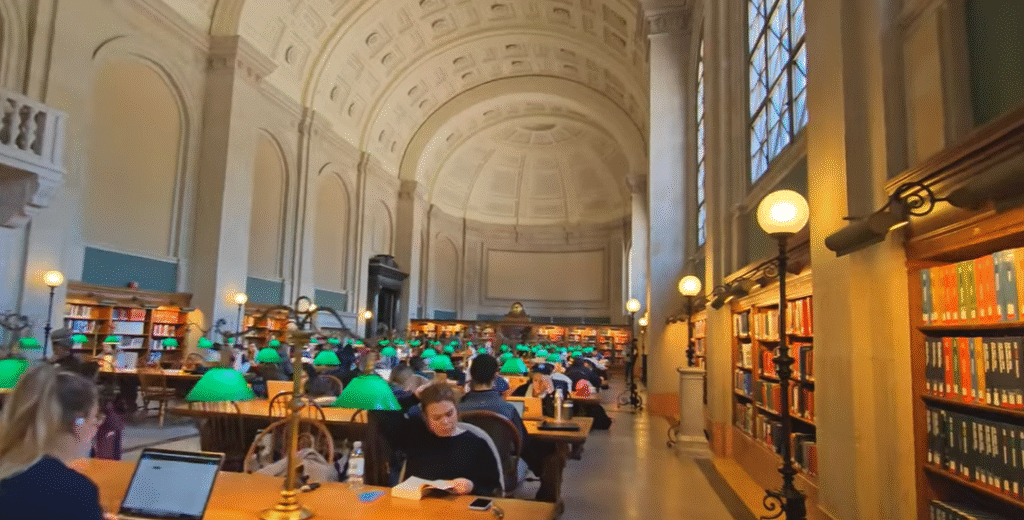When visitors enter the Great Hall of the Library of Congress in Washington, D.C., they are astounded by the marble and stained glass that surround its astounding collection, which is frequently referred to as a cathedral of knowledge. From rare manuscripts that define cultural memory to Jefferson’s personal books, more than 173 million items are preserved here. Though this library offers an exceptionally clear continuity of purpose, it reminds us that access to knowledge has always been a pillar of democracy, much like town squares once shaped civic debate.
The Schwarzman Building at the New York Public Library, located not far north, continues to be one of the country’s most photographed and visited libraries. Its Rose Main Reading Room, which is two city blocks long, is decorated with sky-inspired murals and chandeliers. Its grandeur has been used as a backdrop by Hollywood on numerous occasions, demonstrating how powerfully it shapes cultural imagination. Stories can exist in multiple media at once thanks to the library’s ability to connect literature and film, as seen in Ghostbusters and Breakfast at Tiffany’s.
In contrast, the Boston Public Library was purposefully created as a “palace for the people” and was the first significant free municipal library in the United States. In addition to being aesthetically pleasing, Renaissance Revival architecture was a statement that education was just as important as art. For many years, its halls have been crowded with students, faculty, and casual readers, forming a social fabric that is especially advantageous to Boston’s academic identity. Its marble hallways are remarkably reminiscent of entering an intellectual gallery, with each book serving as a blank canvas for investigation.
| Top Libraries in the US | Location | Key Feature | Notable Connections |
|---|---|---|---|
| Library of Congress | Washington, D.C. | Largest collection globally, 173+ million items | Used by presidents, scholars, and authors |
| New York Public Library (Schwarzman Building) | New York City, NY | Rose Main Reading Room, iconic lions | Filming spot for Hollywood movies |
| Boston Public Library | Boston, MA | “Palace for the People,” Renaissance architecture | Central to Boston’s literary culture |
| George Peabody Library | Baltimore, MD | Ornamental iron balconies, 300,000 volumes | Linked to Johns Hopkins University |
| Beinecke Rare Book & Manuscript Library | Yale University, CT | Houses a Gutenberg Bible, translucent marble walls | Connected to global scholars and rare collectors |
| Seattle Public Library | Seattle, WA | Designed by Rem Koolhaas, futuristic glass structure | UNESCO City of Literature symbol |
| Los Angeles Central Library | Los Angeles, CA | Art Deco architecture, murals, sculptures | Featured in Susan Orlean’s The Library Book |
| Morgan Library & Museum | New York City, NY | Private collection turned public museum | J.P. Morgan’s legacy with priceless manuscripts |
| Brooklyn Public Library – Central Branch | Brooklyn, NY | Art Deco design, modern cultural events | Hub for Brooklyn writers and creatives |
| Carnegie Library of Pittsburgh – Main | Pittsburgh, PA | Founded by Andrew Carnegie, part of museum complex | Landmark in philanthropy and education |
(Reference: Lonely Planet – Libraries to Visit in the USA)

The George Peabody Library in Baltimore is a sight to behold, with a large atrium surrounded by five levels of decorative cast-iron balconies. It has the atmosphere of a book theater, where education is the main attraction. Frequently regarded as one of America’s most exquisite libraries, it draws not only readers but also couples looking for a memorable wedding location. It is immensely adaptable due to this blending of cultural roles, benefiting both academics and artists as well as regular citizens.
In contrast, Yale University’s Beinecke Rare Book and Manuscript Library surrounds its collection with translucent marble walls that emit light at night and glow subtly during the day. A tower of glass houses the Gutenberg Bible and innumerable precious manuscripts. Because it is a haven where history is remarkably resilient and preserved against time in ways that are especially inventive for a mid-century design, scholars come from all over the world to study here.
In contrast, the Seattle Public Library, with its sleek glass-and-steel design created by Rem Koolhaas, is a representation of modernity. The way readers navigate books is challenged by its spiraling shelves, which adds an element of discovery to the reading experience. The structure itself is a civic statement that embodies Seattle’s designation as a UNESCO City of Literature and is noticeably better than traditional designs. It plays a very effective role in determining how the general public can access information, reflecting a city that values innovation and civic involvement.
With its Art Deco elements, vibrant murals, and cultural displays, the Los Angeles Central Library perfectly captures the city’s eclectic spirit. The devastating 1986 fire at the library became both a mystery and a symbol of perseverance in Susan Orlean’s The Library Book. It flourishes once more today, serving as a reminder of how communities can band together to safeguard cultural assets. The resuscitation was incredibly successful, highlighting the importance of libraries even in a city where movies and celebrities rule.
Another type of story is told by the Morgan Library in New York. Previously owned by financier J.P. Morgan, it is now a museum containing rare manuscripts, letters, and artwork. In contrast to the intimidating size of other establishments, its intimate setting creates an atmosphere that feels remarkably purposeful—celebrating the nexus of literature, culture, and commerce. Its exhibitions attract both writers and art enthusiasts, demonstrating how personal interests can develop into valuable public assets.
With its Art Deco architecture, the Central Branch of the Brooklyn Public Library offers both grandeur and accessibility, embodying inclusivity. Its outdoor plaza has been transformed into an urban heartbeat by serving as a venue for events such as concerts, author talks, and get-togethers. Its open support of community events is especially creative in a time when cities struggle with division, demonstrating that libraries are no longer just peaceful places but also hubs for social interaction.
A permanent reminder of Andrew Carnegie’s conviction that libraries serve as stepping stones to opportunity is the Carnegie Library of Pittsburgh. His charitable vision resulted in the establishment of more than 1,700 libraries across the United States, greatly lowering educational barriers for working-class families. The Carnegie Museums and the Pittsburgh main branch continue to serve as a startlingly similar illustration of how knowledge investments can outlast even industrial empires. The footsteps of readers who find empowerment within its walls continue to reverberate through its marble halls.
